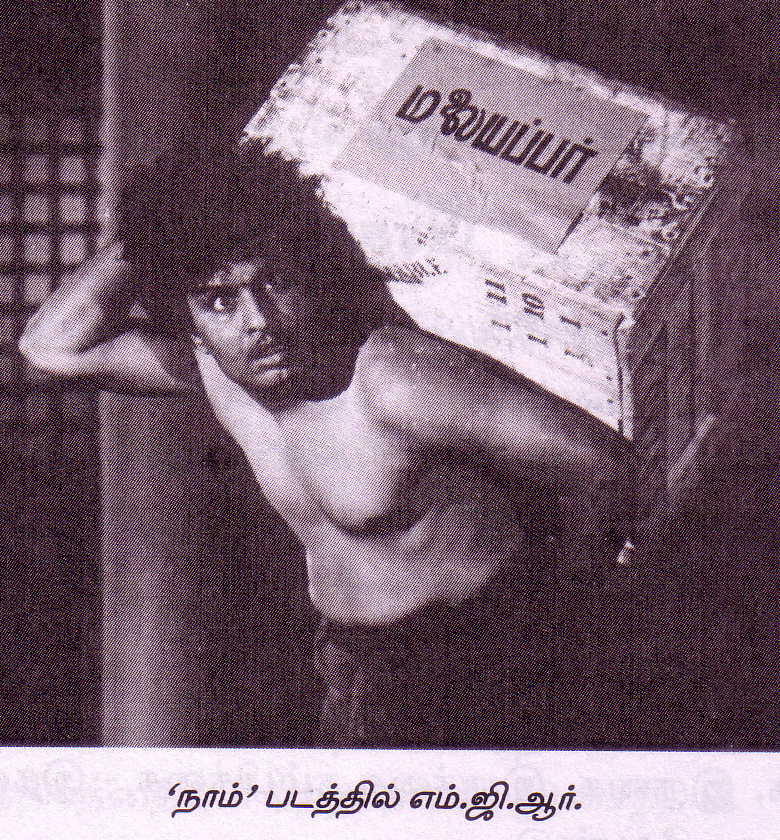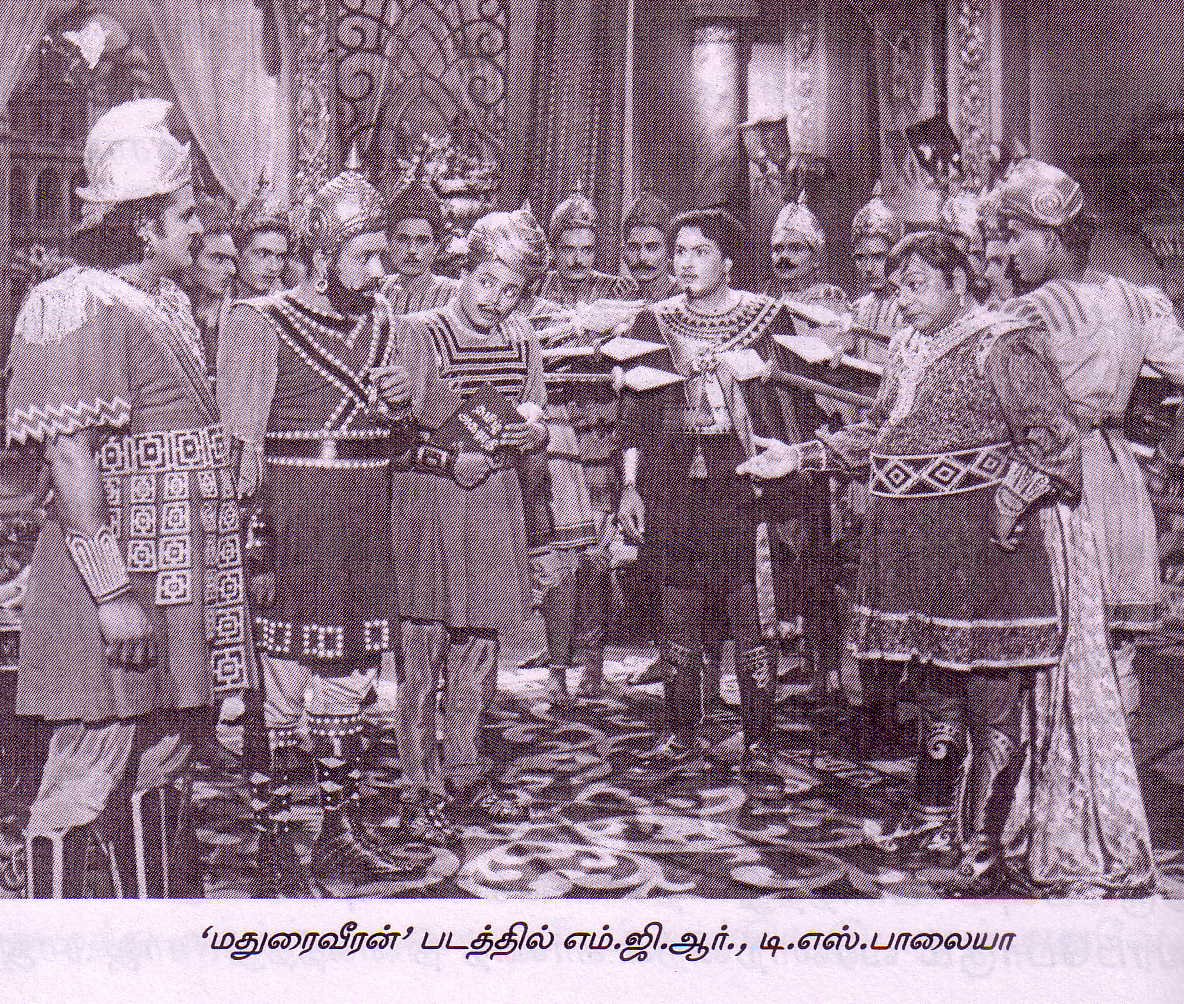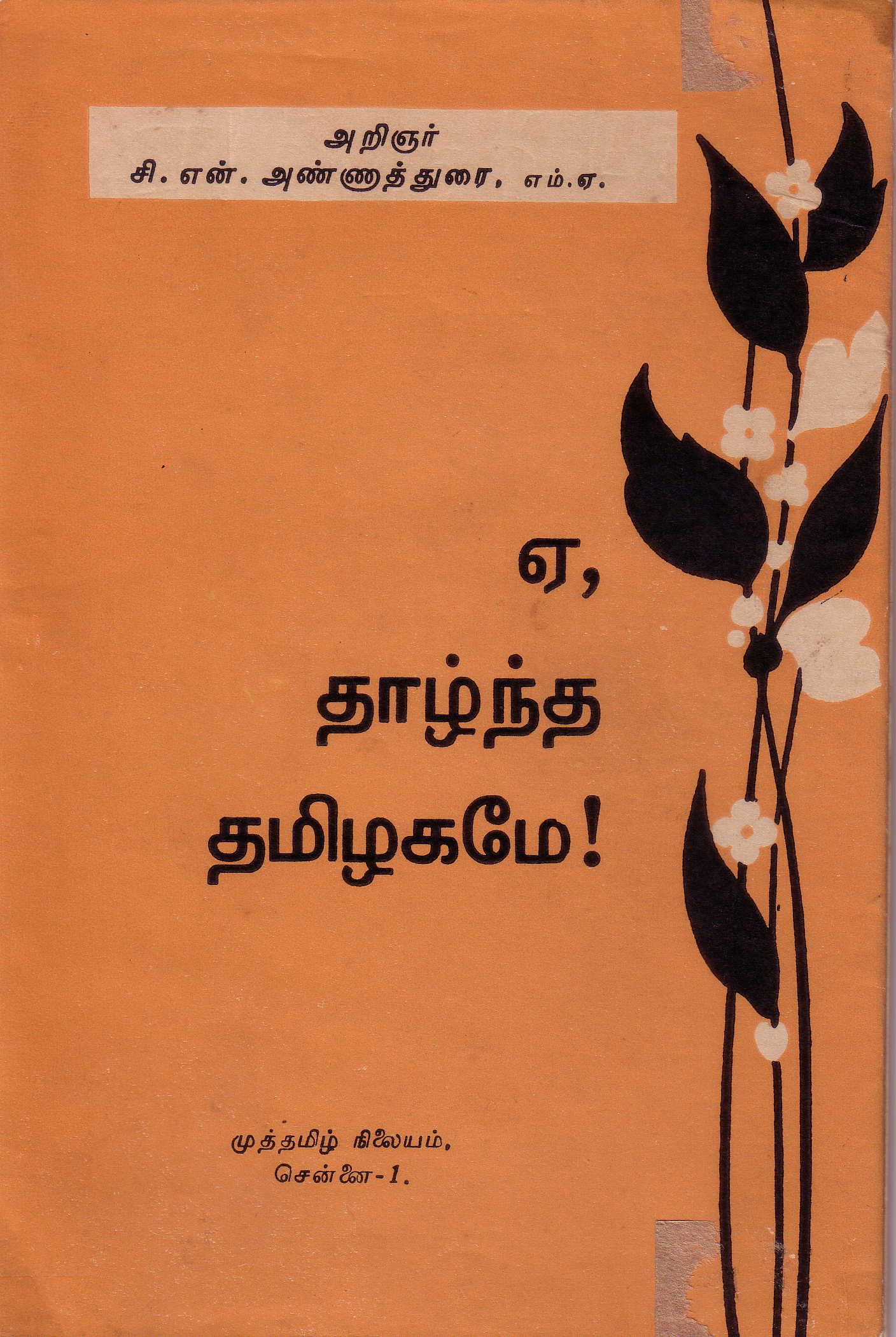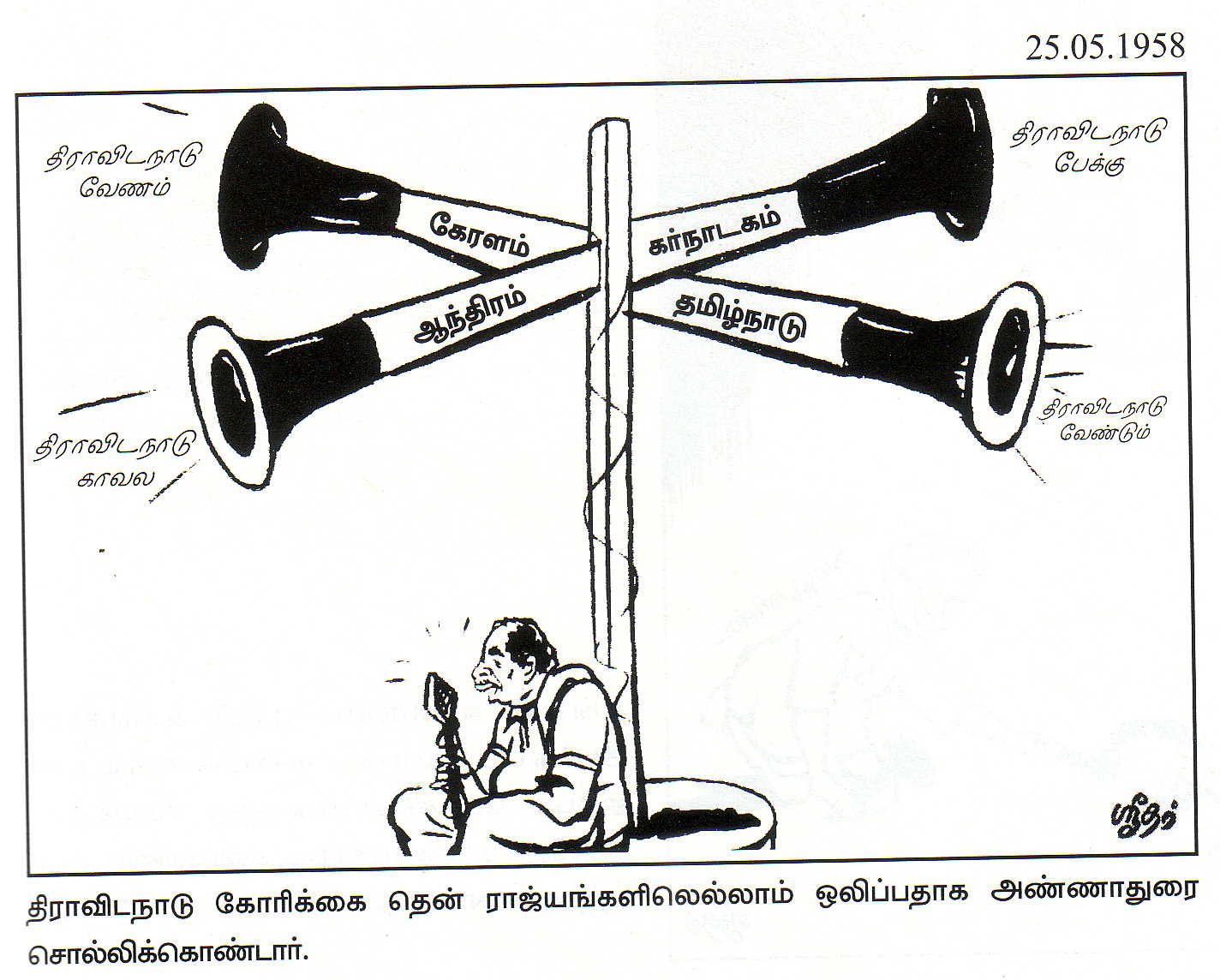By Sachi Sri Kantha, September 30, 2014
A Response received from Mr. Shrikanth Veeravalli
I received an email from Shrikanth Veeravalli on Sept. 6th, related to my review of his recently published MGR biography book (see Part 18). As I requested permission from him to post his details unedited, and he had given me that permission, I provide it below, with my response sent to him.
“Dear Sir,
I am not sure whether this mail will reach you. But this is the one I could find out from the Internet. Will be making further efforts to find a way to communicate to you. Just today, I happened to see you review of the book. Firstly my apologies for the fact that credits are missing before indulging in explanations.
This attempt to write a thin book was to give a brief introduction about one of the tallest leaders from Tamil Nadu a new non-Tamil reading Tamil generation didn’t know about. Given that brief I set it as simple as possible while being in awe with R. Kannan’s work of Annadurai and the huge gulf between such a work and mine. Nonetheless that was the brief and I took it religiously.
If you had noticed, the book has not been edited at all. The second draft was sent by me in August 2010, when DMK was in power and that finds a mention. But after that draft, there was an eerie silence about publication and after 3 long years it suddenly found live in the same draft format without carrying the Bibliography and other sources I used. I even urgently forwarded a mail approval I obtained from Ms. Praminda Jacob to use a portion of her work. But that was of no avail. I am equally disappointed at this, but as the author the blame resides with me and I still take ownership for the faux paus.
Regarding the quote which is not yours, but attributed to you is once again an error stemming out of absence of editing (this is from the Anthology of 11 articles for which you provided a front note) .
I also don’t want to dwell on other inconveniences that were in place. Overall it was a very unsatisfactory experience for me. It could have been much better. I once apologize for the errors that has crept in the book of missing credits and factual ones.
Regards
Shrikanth Veeravalli
PS: Hindu is a leading newspaper in India and I set crossword in that. They have nothing to do with this book. The book was published by Rupa & Co. If you were mentioning with that awareness and as a criticism about me, then it is invalid. Crossword setting is a different creative exercise. There is no connection between writing and crossword setting.
My response to his email, sent on Sept.8, was as follows:
Dear Shrikanth,
Thank you for your mail, which did reach me on Sept. 6th. Thanks also for your thoughts of communicating with me, for my criticism of your first book. I do accept your reasoning for the ‘inconveniences’ and ‘unsatisfactory experience’ with your first book. These are part and parcel of any writer’s life. You have to learn from your experiences, to create a better work next time.
However, I differ from your thoughts which you had written as postscript (PS); i.e., “Crossword setting may be a ‘different creative exercise. There is no connection between writing and crossword setting”. In my view, there is direct link between writing and crossword setting. Both have their origin in words and deals with vocabulary. Lets leave it at that.
I’m still curious to know, something more about you; such as, (1) whether you are a Tamilian or a Kannada native. (2) your age. If you cannot read Tamil, then you might have missed much of original literature about MGR, which was my focus of the criticism of your book.
Lastly, can I request, whether you give permission for me to reproduce your entire letter, in my continuing series on ‘MGR Remembered’. I will not edit your letter at all. Best regards.”
In a subsequent email, Veeravalli did answer that he is a Tamilian from Madurai.
Generativity Concept of Erik H. Erikson
It is somewhat coincidental that psychoanalyst Erik Erikson (1902-1994) published his influential study of human development ‘Childhood and Society’ in 1950. It was also in 1950 that MGR emerged as the hero figure in Tamil movies due to the success of his two movies Manthiri Kumari and Marutha Naatu Ilavarasi. Among the 8 stages of human life delineated by Ericson, at the penultimate stage- maturity, he identified the psychosocial crises facing this period as generativity vs. self-absorption.
Erikson had elaborated generativity in 1950 as follows: “This term encompasses the evolutionary development which has made man the teaching and instituting as well as the learning animal….Generativity is primarily the concern in establishing and guiding the next generation. The concept of generativity is meant to include such more popular synonyms as productivity and creativity, which, however, cannot replace it. [Words in italics, as in the original.]”
Later, in a dialogue with Richard Evans published in 1969, Erikson expressed his generativity thoughts with adulthood stage in life as follows: “At this stage one begins to take one’s place in society, and to help in the development and perfection of whatever it produces. And one takes responsibility for that. I know that generativity is not an elegant word, but it means to generate in the most inclusive sense. If I would call this strength creativity, I would put too much emphasis on the particular creativity which we ascribe to particular people. I use the word ‘generativity’ because I mean everything that is generated from generation to generation: children, products, ideas and works of art.” [Word in italics, as in the original.]”
In case of folks, who are unmarried or unfortunate in not able to produce their own children, Erikson had offered a meaning for their lives. Erikson had stated,
“Even without having children, provided an individual can bear the unavoidable frustration. It is possible for a person to fulfill his generativity by working with other people’s children or helping to create a better world for them.”
Usually adult humans enjoy the thrill of generating their own children. Once this phase is passed, their contribution to the society comes to a standstill. But many talented adults have had less blessing in generating their own children. Even among MGR’s contemporaries, there were individuals like Mother Teresa, Nobel-prize winning astrophysicist Subramanyan Chandrasekhar, MGR’s mentor Anna, Congress Party leader K. Kamaraj, eminent Carnatic musicians like Madurai Mani Iyer and M.S. Subbulakshmi, who were childless either by choice or by circumstances. But they did possess generativity and contributed effectively to the society.
MGR’s Generativity in Movies
Having been childless, MGR’s primary generativity can be identified with the 133 released movies, he starred between 1936 and 1978, in a span of 42 years. Some books on MGR add 3 more movies [Ek The Rajah (1951) – the Hindi version of Marma Yogi (1951), Sarvadhikari (1951) – the Telugu version of Sarvadhikari (1951), and Genoa (1953) – the Malayalam version of Genoa (1953)] which were dubbed and released in other Indian languages by the producers who made the Tamil movies. MGR’s secondary generativity can be identified with his political contributions to Tamil society in Tamilnadu and Eelam between 1967 and 1987. Even among the 133 of MGR’s released movies, he cannot be identified as the prime contributor (or generator) of the first 20 of his movies until 1949, excluding one Rajakumari (1947) in which he starred as the hero. Thus, his generativity was essentially limited to 114 Tamil movies, in which he starred as the hero, and a few movies he produced and directed.
The four movies MGR produced were, Naam (We, 1953), Nadodi Mannan (The Vagabond King, 1958), Adimai Penn (Slave Woman, 1969), Ulagam Suttrum Vaalipan (The Lad who circles the Globe, 1973). Among these, MGR and his elder brother M.G. Chakrapani were collaborative partners in the Naam movie, produced under Jupiter-Mekala banner. Other collaborative partners for this movie included M. Karunanidhi, Rajaram, villain actor P.S. Veerappa and director A. Kasilingam. This movie with a social theme, released on March 5, 1953, failed in box office, for various reasons. According to Tamil movie historian Aranthai Narayanan, one reason mentioned was the absence of ‘DMK political mix’, as the fans had come to expect after Sivaji Ganesan’s debut movie Parasakthi’s (1952) success. The hero and heroine role was played by MGR and his partner V.N. Janaki. Chakrapani also played a supporting role. Veerappa was the villain. Karunanidhi wrote the script. Music director. While Chidambaram S. Jayaraman (Karunanidhi’s brother in law) was the music director, Kasilingam directed it. Another cited reason for this movie’s failure was MGR’s face (he played the role of a boxer) was made unattractive to the disappointment of fans. As a consequence, MGR and his brother Chakrapani disentangled themselves as producer collaborators of Mekala Pictures.
The subsequent production of Mekala Pictures was ‘Rangoon Radha’, released in 1956. This movie was produced by Karunanidhi, Veerappa and director Kasilingam, and adopted from the successful ‘Gaslight’ (1944) plot, directed by George Cukor. DMK leader Anna wrote the screenplay. Instead of MGR, his cinema pal and ‘rival’ in the same DMK camp Sivaji Ganesan covered the role played by Charles Boyer and P. Bhanumathi reproduced the Ingrid Bergman’s heroine role. Following this movie, even Veerappa left the producer collaboration to establish his own company, PSV Pictures. eventually, the Mekala Pictures banner was carried on by Karunanidhi and his nephew Murasoli Maran. MGR created his own ‘MGR Pictures’ for his three subsequent productions.
In previous chapters, based on his autobiography, I had described MGR’s angst about his inability to become a father with his second wife Sadanandavathi. Due to the complex relationship he had with his actor-partner V.N. Janaki during the 1950s, while his second wife was alive, it is a moot question to pose whether he attempted seriously to become a father with his partner Janaki, when he was in his 30s. There had been rumors floating around in 1950s and 1960s that MGR was impotent, based on the single fact that Janaki had had a son with her previous husband. The chances that these sort of rumors were released due to activity of MGR’s professional enemies cannot be discounted. Without supporting medical evidence, one cannot prove conclusively whether MGR suffered from impotence or was subfertile. Why I mention this personal detail about MGR’s health is that, by 1953 (when he joined the DMK party at the age 36) MGR appears to have seriously thought about his generativity in movies, to supplant the lack of generativity in his family life.
DMK Politics of 1950s
Secessionist theme dominated the DMK politics of 1950s. See the two period cartoons on DMK leader Annadurai by Sridhar which appeared in the Ananda Vikatan weekly in 1958. In one, Anna is shown as promoting the Dravida Nadu (consisting of Andhra, Kannada, Kerala and Tamil Nadu) in his microphone, while the 3 loud speakers (tagged Andhra, Kannada and Kerala) reject the demand and only Tamil Nadu speaker releases an affirmative voice. In the other cartoon, Anna is pushed from his chair with the label ‘North-South propaganda’ by the police. The caption below states that the police auctioned Anna’s sofa to collect payment from him.
Mythological stories drawn from epics and the Puranas had become passe, after the eclipse of singing stars M.K.Thygarajah Bhagavathar and P.U. Chinnappa, by MGR and Sivaji Ganesan. DMK’s main plank of Tamil pride, North-South distinction (Arya-Dravida conflict) and societal discrimination based on caste became the major themes in ‘costume dramas’ based on historical themes involving the lives of princes and folk heroes. Ten of MGR’s popularly successful movies of 1950s (Marutha Naatu Ilavarasi, Manthiri Kumari, Marma Yogi, Malai Kallan, Gul-E-Bakaavali, Ali Babavum Narpathu Thirudargalum, Madurai Veeran, Maha Devi, Chakravarthi Thirumagal and Nadodi Mannan) reflected this trend.
MGR had claimed that he was attracted to DMK by Anna’s writing. One of the popular tracts of Anna was E! Thazhntha Thamizhagame!” (Hey! Lowly Tamil Nadu). Originally, it was an inspirational speech made by Anna (when he was still at the Dravida Kazhagam of Periyar E.V. Ramasamy Naicker) on September 20, 1945 at the convocation ceremony of Annamalai University to honor the services of Tamil revolutionary poet Bharathi Dasan (1891-1964). Later, it was printed and sold. Towards the end of the speech, Anna alliteratively tweaked the nerves of Tamilians who demanded self-respect in Indian society. In translation, Anna’s words rhymed as follows:
“Hey Tamil Nadu! Hey Lowly Tamil Nadu! Blunted Tamil Nadu! One who had forgotten itself – Tamil Nadu! Self-respect demolished Tamil Nadu! Gratitude-less Tamil Nadu! Arts-insensitive Tamil Nadu! One who doesn’t know the sense of God – Tamil Nadu! Believing that being cheated is fun – Tamil Nadu! Hey listless Tamil Nadu! Wake up from slumber! Greet the truthful poets! Real poets! Revolutionary poets!”
MGR’s revolution in Tamil cinema
Of course, MGR was adept in dialogue delivery. But a ‘revolution’ he made in Tamil cinema of 1950s was to reduce dialogue delivery in his movies, and deliver the same message in inspirational songs. He might have adapted this strategy for two reasons. First is to differentiate himself from his fellow DMK rival – Sivaji Ganesan, a genius in that segment. Secondly, to escape from the scissors of Congress Party-sponsored censor board. That MGR was a quick study of trends had never been disputed in cinema circles. How the DMK-sponsored movie ‘Sorga Vaasal’ (Gates to Heaven, 1954) scripted by Anna, featuring DMK’s singer-actor K.R. Ramaswamy was mangled by the censor board for political reasons might have influenced MGR’s sensible antenna. Having chosen the path of not singing, he had to choose elite lyricists, lyrics arrangers (aka music directors) and playback singers to promote pro-DMK songs. In this, MGR was blessed. Those who had talent, received MGR’s nod, irrespective of political affiliations. Among the lyricists, he promoted Pattukottai Kalyanasundaram (1930-1959) though the latter had Communist sympathies. There were other lyricists Bharathidasan, Udumalai Narayanakavi (1899-1981), Tanjai Ramaiya Das (1914-1965) and last but not the least Kannadasan (1927-1981). Among the music directors, talent was aplenty and MGR had to chose among G. Ramanathan, K.V. Mahadevan, his close pal S.M. Subbiah Naidu, and Visvanathan-Ramamoorthy duo. For playback singers, he could rely on four elite Tamil singers Tiruchi Loganathan, Chidambaram S. Jayaraman, T.M. Soundararajan and Sirkazhi Govindarajan. The magic produced by the collaborative efforts of these lyricists, music directors, singers and MGR still reverberate in numerous songs extolling Tamil pride.
If I’m not exaggerating, these movie songs had become the 20th century ‘devotionals’ among the Tamil illiterates replacing the religious hymns of Hindu saints of the earlier centuries. Who are Tamil illiterates is another realistic question. Isn’t the children and grandchildren (who cannot read and write Tamil language) of Tamil professional migrants living in the industrialized countries in the 21st century should also be termed as Tamil illiterates?
Not only male playback singers, even female playback singers like Carnatic diva M.L. Vasanthakumari had a song extolling the Tamil pride – ‘Senthamizha Elunthu Vaaraayo- Un singara thaai mozhiyai Paarayo’, (lyricist Kannadasan) in ‘Madurai Veeran’ movie to attract the women fans. Apart from Tamil pride, MGR also focused his attention on the listlessness among Tamil workers, with catchy folk tunes. A few songs of this mode include, Summa Iruntha Sorrukku Nattam (If one idles, food will be lost; lyricist Udumalai Narayana Kavi) in Maduri Veeran movie and Thoongaathe Thambi Thoongathe – Nalla Somberi Enra Peyar Vaangaathe (Don’t sleep brother – and gain the name as a weary fellow; lyricist Pattukottai Kalyanasundaram) in Nadodi Mannan movie. Society’s dregs, parasites and land-owning class (zamindars) were also targeted with catchy songs like, Eththanai Kaalam Thaan Emaruvar Intha Naatile (How long these guys will be cheating us; lyricist Tanjai Ramaiah Das) in Malai Kallan movie, and Kurukku Vazhiyil Vaazhvu Thedidum Thiruddu Ulagamada (The world which revels in crooked route to rob and live; lyricist Kalyanasundaram) in Maha Devi movie.
The MGR movie song which symbolized the Tamil pride sentiment of DMK politics was written by poet Kannadasan for the Mannathi Mannan (King of Kings, 1960) movie, when the lyricist was in the party. The first two lines of this lyric were,
‘Achcham enpathu madamaiyadah- Anjaamai Dravidar udamaiyadah
Aarilum saavu noorilum saavu – Thayakam kaapathu kadamaiyadah’
In my English translation, the entire lyric read as follows:
“Fear is none but cowardice – and the symbol of Dravidas is chivalry
At six or at hundred one could die – but protection of homeland is the duty.
For the growing fetus in her body, a Tamil mother teaches bravery
In challenging times, to protect her face, there will rise her progeny.
Many have lived and many have died- but in the minds of masses who stay long?
Those blessed with great heroics and chivalry live forever in the annals of history.”
After MGR’s death, journalist Sam Rajappa summarized the hold of MGR persona among Tamil masses as, “Having tasted the heady sense of adulation, MGR slowly built up his personal stock while in the DMK. He created the image of an action hero who used his fists more than his tongue. He showed the masses through his films the importance of fighting to help themselves.” In one of my earlier commentaries on MGR as a role model for heroism among Tamil militants in 1988, I included this comment of Rajappa. When this commentary was posted electronically in the now defunct Tamil Nation website,
I received an email from an irritated Sinhalese correspondent named Saman Jayanetty from Australia. I selectively quote from this 2007 email.
“Dear Dr. Sri Kantha,
I read your article ‘Role Models for Heroism among Tamils’ on www.tamilnation.org and found that it would be very helpful for creating Tamil ‘heroes’ in the years to come… Given the fact that you are seemingly an MGR follower, you must be very intelligent and I am happy about that. You have shown your level of education by considering MGR actor, who used his fist more than his tongue (this is from your own article, in fact), as a role model for Tamils. What great thinking! Hell to the tongue, fist will create ‘heroes’, I think that’s the message you, as an educated adult, want to convey to the young Tamil kids…”
I didn’t reply to this irate correspondent, as he had missed the focal point of my commentary and was ignorant of the contemporary world and cinema. What is wrong with MGR using his fist than the tongue for extoling Tamil pride, if it was OK for Hollywood heroes like John Wayne, Clint Eastwood, actor-turned President Reagan or even idolized Sinhala movie heroes like Gamini Fonseka?
MGR’s main contribution to Tamil movies in 1950s was to chase the devil of psychological paralysis and uplift the wounded Tamil morale. Walter Wanger (1894-1968), an American film producer, contributing a commentary to the American Journal of Sociology wrote in 1941, that movies as a medium of communication can be used to clarify, to inspire and to entertain. This was at a time, when Americans were tentative, unsure and confused about their role in the Second World War. Elite critics may disagree on realism and artistic nuances of film making; but without doubt, it could be said that MGR’s movies of 1950s inspired the Tamil citizens and afforded individual relaxation to day laborers struggling with life’s burden.
Cited Sources
Richard I. Evans: Dialogue with Erik Erikson, E.P. Dutton & Co, New York, 1969.
Erik H. Erikson: Childhood and Society, 2nd edition, W.W. Norton & Co, New York, 1963.
Randor Guy: Blast from the Past series Sorgavaasal (1954). The Hindu (Chennai), Feb.17, 2011.
Aranthai Narayanan: Thamizh Cinemavin Kathai, 3rd ed., New Century Book House, Chennai, 2008. (in Tamil).
T.S. Narayana Swamy (ed): Autobiography of an actor Sivaji Ganesan, Sivaji Prabhu Charities Trust, Chennai, 2007.
Sam Rajappa: Celluloid hero who became a state’s leading man. Far Eastern Economic Review, Feb.4, 1988, pp.70-71.
MGR: Naan Yean Piranthen? (Part 2), Kannadhasan Pathippagam, Chennai, 2014. (in Tamil)
- Sivathamby: Politicians as players. The Drama Review (TDR), 1971 spring; 15(2): 212-220.
Sridhar: Sridhar Cartoons. Vol.1, Vikatan Pirasuram 500, Chennai, 2010.
Sachi Sri Kantha: Role models for heroism among Tamils. Tamil Times (London), Sept. 1988, p.19.
Walter Wanger: The role of movies in morale. American Journal of Sociology, 1941 Nov.; 47(3): 378-383.





A Correction by Sachi:
For the ‘Rangoon Radha'(1956) movie, title credits show Karunanidhi wrote the screenplay. Anna was indicated as the source of story. The information that it was adapted from ‘Gaslight’ movie comes from Sivaji Ganesan’s autobiography.